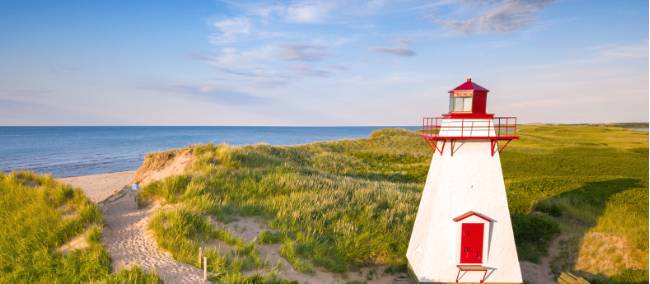
Lighthouse views on Prince Edward Island | Tourism PEI/Sander Meurs
Learn something new before visiting the 'Gentle Island'
by Robin Esrock
If you've booked your trip or thinking about exploring Prince Edward Island, it's a good idea to arm yourself with the facts. Not about the weather, time zones, or other practical details you'll find in GCT's extensive Trip Notes. No, I'm talking about facts that straddle the line of trivia, fun, and who knew? Below you'll find information to casually mention over a craft beer somewhere along your journey, earning you instant respect from companions and locals alike.

1. 50 million Pounds
PEI harvests over 50 million pounds (that's about 22,730 tonnes) of mussels every year, accounting for 80% of Canada's mussel production. High-quality mussels thrive in clear, clean seawater, which is why rope-grown PEI mussels are the biggest selling mussel in North America. They are farmed, processed and shipped around the world 365 days a year, and you'll likely see a mussel farm in one of 19 shallow bays and inlets across the island. PEI mussels are naturally occurring, sustainable, protein-rich, and contain more iron and vitamin B12 than beef. Bon Appetit!
2. Taste the Bay
On the subject of seafood, PEI is also renowned for the quality of its lobsters, clams, and prized oysters. Named for the distinct inlets from which they originate, PEI oysters possess a unique taste and quality imparted by their location. Malpeque oysters have a clean, briny and crisp finish and a small teardrop shaped shell. Raspberry Point oysters are similarly salty, a little larger with a bit of crunch and sweet finish. Colville Bay oysters are medium salty and nutty in flavour, with a floral lemon zest finish. Badeque, Rustico, Valley Pearl, New London – eat enough oysters around the island, and it won't take long before you can identify their origin bay by taste alone.

3. Iron Paradise
In PEI, mussels and oysters are not the only things rich in iron. The island's famous red cliffs and beaches result from iron-rich minerals oxidizing when exposed to air. PEI has dozens of beaches and strolling along that soft red rosy sand is a highlight for many visitors. Note: you might want to leave your white clothing at home as the rusty colour does rub off on clothing. A Mi'kmaq legend tells how the soil got its distinctive hue: When the Great Spirit formed Mother Earth, he was left with a large amount of red earth. The Great Spirit fashioned it into a crescent surrounded by singing waters, adding lush forest, flowers and grassland and gifting the most beautiful place on Earth to the Mi'kmaq people.
4. 12,000 Years
The Mi'kmaq have called this island home for an estimated 12,000 years, naming it Epekwitk, which means "lying on the water." You'll encounter Mi'kmaq names for many places around the island and can engage with various Indigenous tourism experiences on Lennox Island or through the community at Abegweit. Tourism is a wonderful tool to make connections and bridge cultural gaps, and while we're on the subject of bridges…

5. Confederation Bridge / Epekwitk Crossing
At 12.9km/8mi long, it is the world's longest bridge spanning ice-covered water and the longest bridge in Canada. The 'Fixed Link' between the New Brunswick mainland and PEI may be an engineering marvel, but it was a controversial undertaking when construction began in late 1993. Some locals wanted their island safely removed from highway traffic, while others saw the opportunities for increased trade and tourism. A referendum in 1988 resulted in a 59.4% vote for the Confederation Bridge, which was finally completed in 1997. The toll bridge carries two lanes of traffic, and unfortunately for us is prohibited for pedestrians and bicycles. Drivers only pay the toll when leaving the island. In May 2022, the PEI Legislature passed a motion urging the federal government to change the bridge's name to Epekwitk Crossing. Shortly before you pedal onto the Confederation Trail, you'll find fantastic views of the bridge at Chelton Bridge Provincial Park and Borden-Carlton Historical Park.
6. Those Green Gables
Set among the rolling green farmland and small-town shenanigans of PEI, Lucy Maud Montgomery's novel Anne of Green Gables (and the eight sequels that followed) captivated the world with the daily lives of early 20th-century PEI citizens. With more than 50 million books sold, Anne is the island's cultural icon, a scrappy young girl who grows into an upstanding lady and a commercial licensing opportunity that just keeps on giving. Visitors flock to Green Gables Heritage Place, the long-running summer musical in Charlottetown, and the historical village of Avonlea brought to life with costumed re-enactors. Gables, by the way, is not a name for farmland or fields but a term for the triangular part of a house's exterior wall. Anne of Green Walls didn't sound as good. For those with little interest in the fictional antics of Canada's Alice in Wonderland, you can always peddle through the rolling farmland of Cavendish or to the coastal dunes of nearby PEI National Park.

7. An Island in Numbers
The smallest province in terms of land size and population (at 5,620km2/2,190mi2, it makes up 0.1% of Canada), PEI has a population of 165,000, and according to the 2022 census, it is the fastest growing province in the country with a population growth rate of 8%. The island has 33 golf courses, 60 provincial parks, and two cities in Charlottetown and Summerside. No place on the island is more than 16km/10mi from the sea, and you ride the island from Tip to Tip along the 273km/170mi-long Confederation Trail. The new cross-Island Walk, modelled after the famous Camino in Spain, covers 700km/434mi over 32 sections. PEI has 800/500mi kilometres of beach, and the island's highest point is just 152m/500ft above sea level, making it ideal for cyclists wishing to avoid large hills!
Robin Esrock is a renowned travel journalist and the bestselling author of The Great Canadian Bucket List.